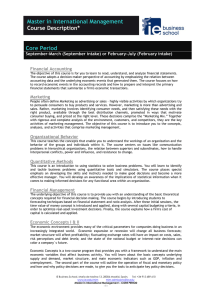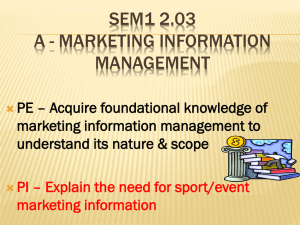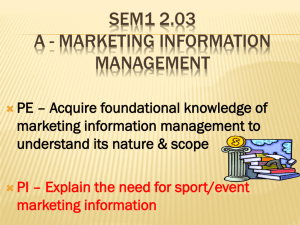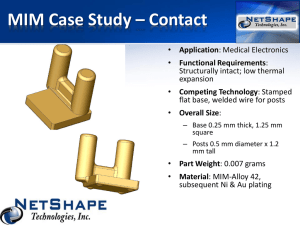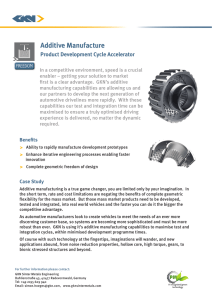MIM Technology
advertisement
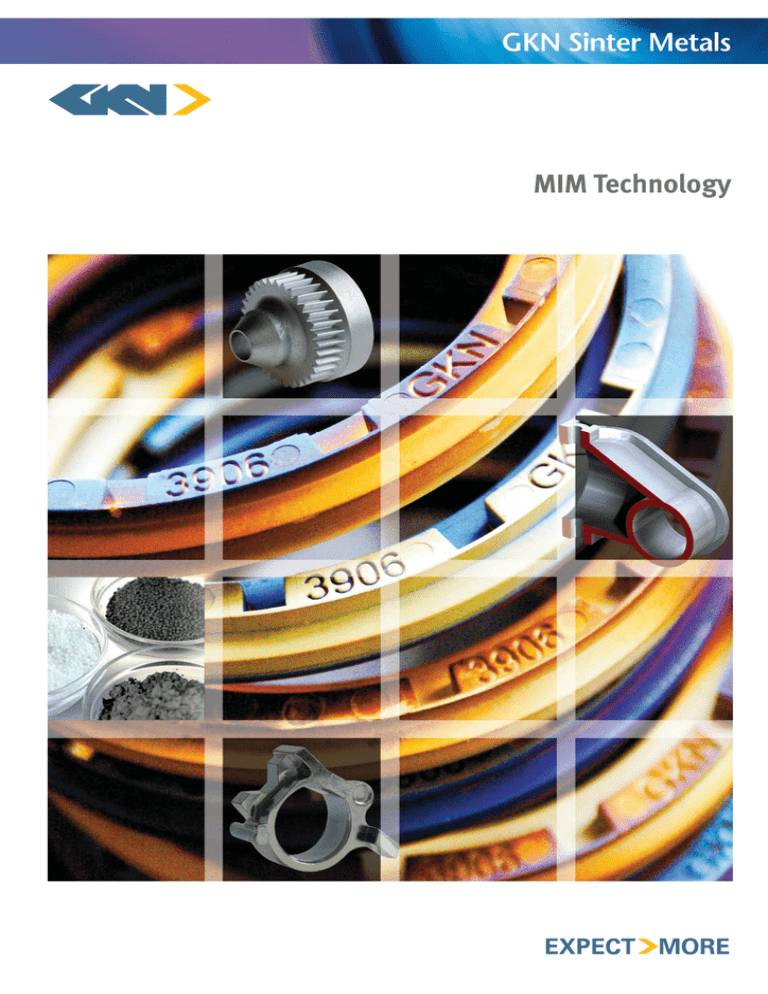
MIM Technology
MIM – Let Your Ideas
Innovative components meeting technical challenges often require a complex design and
superior material properties; high manufacturing costs often prevent them from being realised. The freedom of shape offered by MIM (metal injection molding) technology provides a
universal platform for design engineers and product designers to develop creative solutions
and at the same time observe tight target costs. Applications that used to be manufactured
by more costly conventional processes can now take advantage of the cost savings of MIM
technology.
2
Come True
MIM components combine the outstanding material properties of metal and the complex design options of plastic technology. Shaping by the injection molding of metal powders
(MIM) offers maximum freedom with respect to part geometry
and material options far exceeding the design possibilities of
machining and casting technologies.
Undercuts, bores and blind holes can be formed in any direction. Wall thickness of 1 mm or less as well as bore diameters
of just a few tenths of a millimetre can be realised.
Relief-like structures and engravings such as company logos
or identification marks can be produced in detail. Even the
use of expensive high strength alloys, corrosion resistant and
other premium steels is possible as no additional machining
costs are incurred.
MIM components achieve an excellent surface finish (usually
surface roughness values Ra < 1 µm) without any subsequent
operations. The microstructure of the sintered components
allows electroplating and electro-polishing without any pretreatment.
The depth of penetration after case hardening is comparable
to the values of forged steels. MIM materials are usually weldable too.
3
MIM – Enjoy the Benefits
The benefits of MIM processing can best be exploited if MIM design concepts are employed in the
development phase. Entirely new possibilities for
dimensional and shape design are opened to the
design engineer.
High volume production of highly complex components
is economical due to fully automatic MIM processing and
yields process reliabilities conforming even to the strict requirements of the automotive industry
The flexible geometric design can even be applied to high
strength metals and premium steels
Applications of plastics, aluminium, or zinc die castings
whose loading conditions are at the limit can be replaced by
high strength MIM parts
Costly joining or assembling techniques can be avoided by
designing complex MIM components that can replace two
or even more assembled parts
Threads can be produced in the primary shaping process
(ie injection molding)
Material and costs can be saved by optimising the part volume. Weight reduction leads to further savings for dynamically loaded components in the form of a reduced moment
of inertia
The most intricate geometries are exactly reproduced in detail
Even innovative alloy materials according to specific customer requirements can be economically processed
4
Metal injection molding technology offers virtually
unlimited design freedom to the design engineer –
these are just a few examples of the possible variety
of shapes.
MIM – Its Strengths in
Summary
3 dimensional
dimens
sional complexity:
The forming process of MIM technology is closely related to
traditional plastic injection molding and thus allows the same
level of complexity in a regard to the design geometries.
Parts with bore holes, blind holes, slots, notches, inner and
outer threads, recesses, undercuts, structured surfaces, and
cavities are made by MIM without problems. Similarly sophisticated design elements are not feasible with alternative chipless shaping processes.
Weight reduction:
Optimum part design allows for weight reduction without losing functionality. Weight reduction has a positive effect on
the cost of the finished product.
High productivity:
When large numbers of identical parts are required, the cost
advantage of MIM technology is particularly evident. Depending on the application, even highly complex components can
be made without costly finishing operations. This is why this
technology is particularly suitable for high volume production.
5
MIM – A Highly Technical Manufacturing Process
1.) Feedstock preparation
For the preparation of the feedstock, metal powders are first
blended according to the desired alloy composition. Then
thermoplastic polymers and additives are kneaded with the
powder mix and heated to obtain a viscous mass. The mass is
then cooled down and processed into granular pellets (feedstock).
The metal powder alloy determines the mechanical and chemical properties achieved by the finished product. GKN engineers have excellent know-how for powder development as
well as for controlling the feedstock properties achieved.
2.) Injection molding
Thermoplastics injection molding machines with special modifications are used in MIM technology, similar process as applied in conventional plastics injection molding.
After being dosed and fed into the injection unit the input material (feedstock) is molten and densified in front of the screwconveyor. By a forward movement of the screw the plasticized
mass is injected with high pressure through a sprue and runner system into the individual cavities of the mold.
Subsequently the mass is 'frozen' inside the mold cavities
with their geometric design ('green compact'). After cooling
down to the ejection temperature the mold is opened along
the parting plane. The solidified parts, ie the green compacts,
are ejected from their cavities by means of ejection pins and
can then be removed by suitable handling systems.
6
MIM – Metal Injection Molding
Green compacts are characterised by:
portions of approximately 10% binder and 90% metal powder
strength similar to thermoplastic polymer parts
homogeneous powder distribution without particle alignment
3.) Debinding and sintering
Subsequent debinding serves to remove the polymer binder
from the green compacts. At GKN Sinter Metals this first step
is carried out in continuous sintering equipment.
A catalyst is fed into the debinding muffle which is evaporated at temperature, thereby forming a reactive atmosphere
by which the polymer is completely de-polymerised. The binder is continuously degraded during the reaction and escapes
in a gaseous form from the compact. The resulting structure
has an open porosity. This porous structure is known as the
'brown part'.
The brown parts are directly transferred into the sintering
muffle. Here the temperatures are increased almost to the
melting point in a well-controlled process until the metal particles sinter. The furnace atmospheres applied may be inert
or reducing.
Processing conditions in the computer controlled equipment
are precisely monitored. Only due to this effort is it possible
to keep the 16 to 18 percent shrinkage of the parts under control in order to attain the final dimensions as specified by the
customer.
7
MIM – Secondary Processing
MIM components can be further processed and enhanced in many ways. Among others, the following
processes may be applied:
8
Heat treatment
Hardening, tempering, quenching
and tempering, surface hardening, case hardening
Physicochemical surface
treatment
Nitriding, carbonitriding, nitrocarburizing, boriding, siliciding
Chemical surface treatment
Pickling, chemical deburring,
burnishing, etching
Mechanical surface treatment
Engraving, barrel finishing, grinding, polishing, deburring, shot
peening
Applying nonmetallic anorganic coatings
Chromatising, phosphating,
anodizing, enamelling
Applying metallic coatings
Electroplating, chemical metal
coating, melt dip coating, metal
spraying, chromizing
Applying organic coatings
Printing, adhesive bonding,
varnishing
Applying wear resistant
coatings
CVD coating, PVD coating
MIM - Dimensional
Tolerances
MIM dimensional tolerances*
[mm]
Nominal dimension X
[mm]
Standard tolerance
[mm]
Up to 3
+/- 0,05
3 <x> 6
+/- 0,06
6 <x> 15
+/- 0,075
15 <x> 30
+/- 0,15
30 <x> 60
+/- 0,25
(* Given tolerances serve as guidelines)
Parts / Year
die casting
low
investment
casting
average
Part Complexity
The standard dimensional tolerances given in the adjoining
table are generally achieved after sintering with consideration of the 16 to 18 percent shrinkage.
These standard values are just guidelines since the real dimensional tolerances depend on the geometry and material
composition and therefore can easily vary.
If even closer dimensional tolerances are required, these
can sometimes be achieved by re-designing the MIM component.
In addition to that, GKN offers a variety of chipless and chipping finishing operations in order to conform to the highest
requirements.
MIM – compared to competing technologies
If the strengths and benefits of MIM technology are employed
at the design stage, substantial advantages can be achieved
over almost all conventional technologies. These are usually
reflected as improved function and enormous cost savings.
MIM paves the way to simplify entire component assemblies
by reducing the number of individual parts. This helps to reduce the sources of error in the manufacturing process, enhance process reliability and thus guarantee higher quality.
presssinter
machining
Typical tolerances of sintered MIM components
high
Résumé: MIM technology proves economical where complex
shaped components with close dimensional tolerances, demanding mechanical properties and excellent surface finish
are required.
9
MIM - Guidelines for Part
Design
In order to fully exploit the inherent potential of
MIM technology, these guidelines for part design
should be observed at the earliest possible design
stage.
We have compiled the most important design principles in the following graphics – for optimum MIM
design from the beginning!
Example: fixture
Flat bottom face
MIM components exhibit about 16 to 18 percent shrinkage during the debinding and sintering process and therefore require a sliding bottom surface.
Ideally a flat bottom face should be designed for sufficient
part stablility. This can help to avoid distortion and resulting
subsequent leveling costs.
Threads
Inner threads that are planned in the design stage can be
shaped by MIM in the primary shaping process, provided they
are designed adequately and can be realised by so-called
„spinning cores“.
10
Example: shaft guide
Radii
The use of radii on edges, for example, has several positive
effects on the overall picture of the MIM component. Not only
are handling and aesthetic appearance of the finished parts
improved, but also the material costs can be reduced. Rounded edges improve the strength, too, as the load is better distributed.
Weight reduction
Weight reduction can best be realised by creating free space
in the MIM component. Besides reducing the weight of the
component, the reduction of material cost also leads to a lower
sales price of the part.
Further the dynamic properties of the component can also be
improved.
Example: linking block
Constant wall thickness
If possible, the wall thickness should be constant all over the
part and abrupt wall changes should be avoided. This guarantees a uniform mold fill during injection molding.
Ribs and links
Ribs and links serve to stiffen the part and mainly improve the
strength of the MIM component. These design elements can
also be used to improve the dimensional accuracy.
11
About GKN Sinter Metals
Production Plants
Argentina
GKN Sinter Metals – a wholly owned
subsidiary of U.K.-based GKN plc,
a global industrial company – is the
world’s largest producer of precision
powder metal products. With a focus
on superior delivery, quality and total
solutions, the company offers
extensive technical expertise in
design, testing and various process
technologies. GKN Sinter Metals
offers a full range of more than
10,000 complex shape, highstrength
products for the automotive,
commercial vehicle, home
appliance, lawn and garden, office
equipment, power tool, recreational
vehicle and process industry markets.
The company’s global footprint
spans more than 13 countries
across five continents. GKN Sinter
Metals is in close proximity to its
customers with more than 30 global
locations and a workforce of
approximately 5,500 employees.
For more information about GKN’s
world of solutions visit
www.gknsintermetals.com
India
GKN Sinter Metals de Argentina S.A.
Ruta Nac. 5 Km. 159,5
(B6622GKA) Chivilcoy – Bs. As.
Argentina
GKN Sinter Metals Ltd.
146, Mumbai Pune Road
Pimpri, Pune 411 018
Maharashtra, India
Phone:
E-mail:
Phone:
E-mail:
*54-11-5368-3700
infoargentina@gknsintermetals.com
*91-20-2742-6261, 6262, 6263
infoindia@gknsintermetals.com
Italy
Brazil
GKN Sinter Metals Ltda.
Av. Emancipacão, 4.500 - Santa Esmeralada
CEP 13186-542
Hortolandia – SP – Brazil
GKN Sinter Metals SpA
Fabrikstraße 5
39 031 Bruneck (BZ)
Italy
Phone:
E-Mail:
Phone.
E-mail:
*55-19-2118-9400
infobrazil@gknsintermetals.com
*39-0474-570211
infoitaly@gknsintermetals.com
North America
Canada
GKN Sinter Metals – St. Thomas Ltd.
7 Michigan Boulevard
St. Thomas, Ontario
Canada N5P 1H1
GKN Sinter Metals
3300 University Drive
Auburn Hills, Michigan 48326-2362
USA
Phone:
E-mail:
Phone:
E-mail:
*1-519-631-4880
infona@gknsintermetals.com
*1-248-371-0800
infona@gknsintermetals.com
South Africa
China
GKN Sinter Metals – Danyang
Number 7 Mechanical Industry Park
Danyang Development Zone
Danyang,
China
GKN Sinter Metals – Cape Town
P.O.Box 156
Sacks Circle
Bellville, 7530
South Africa
Phone:
E-mail:
Phone:
E-mail:
*86-511-86-885-556
infochina@gknsintermetals.com
*27-21-950-6200
infoafrica@gknsintermetals.com
Germany
GKN Sinter Metals Engineering GmbH
Krebsöge 10
42 477 Radevormwald
Germany
Phone :
E-mail :
*49 2191-693-0
infogermany@gknsintermetals.com
GKN Sinter Metals Sales Offices Worldwide
China
E-mail:
France
E-mail:
GKN Sinter Metals Filters GmbH
Dahlienstraße 43
P.O.Box 1520
42 477 Radevormwald
Germany
Phone:
E-Mail:
*49 2195-609-27
feedback@gkn-filters.com
infochina@gknsintermetals.com
infofrance@gknsintermetals.com
Japan
E-mail:
infojapan@gknsintermetals.com
Korea
E-mail:
infokorea@gknsintermetals.com
Spain
E-mail:
infospain@gknsintermetals.com
Sweden
E-mail:
infosweden@gknsintermetals.com
United Kingdom
E-mail:
© Copyright by GKN Sinter Metals - Rev. 1.0
infouk@gknsintermetals.com
